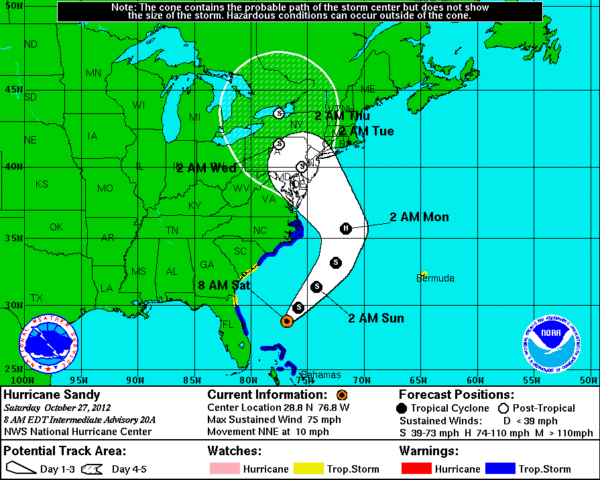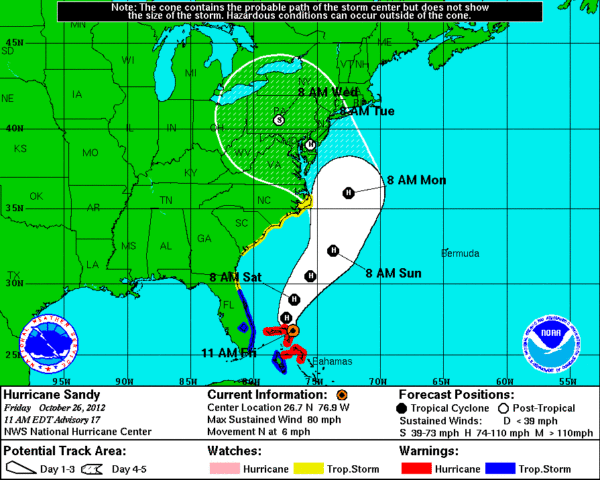News
Numerous articles linked and referenced the BirdCast website during the extensive media coverage of Hurricane Sandy. The following is a list of links to radio, print, and Internet coverage of the storm relevant to (or referencing) BirdCast. Discovery.com – EXCELLENT IDEA OF THE DAY: POST-SANDY BIRDING NewsDay – Exotic birds traveled to Long Island with Sandy […] Read more...
To follow yesterday’s post, get out a look for landbirds!!!! Something extremely interesting is occurring in the wake of the epic passage of Sandy. Recent reports from Maryland to Maine of a bizarre mix of Neotropical migrants, including Connecticut Warbler (MD), Yellow-billed Cuckoo and Scarlet Tanager (NY), and Eastern Wood-Pewee (MA), suggest that the effects […] Read more...
With the departure to the Northeast of Hurricane and Post-Tropical Cyclone Sandy, westerly flow prevails outside the Northeastern US across a huge portion of the Eastern US from the western Great Lakes through peninsular Florida. In many areas, despite the late date, later season migrants including waterfowl and passerines will take flight. Widespread light to […] Read more...
For those out birding from the mid-Atlantic through New England and west to the Appalachians and the eastern Great Lakes, today was a wild day of birding. Several blogs have captured the ornithological events spawned by Sandy’s arrival onshore, and numerous meteorological sites have detailed the extreme devastation of the storm. As a final component […] Read more...
The remnants of Sandy, huge as they are, have a circulation that has just passed Philadelphia, PA. All of the meteorological forecasters involved in predicting the path of this system did quite an amazing job – now, team eBird and BirdCast will get to see how we did at predicting the ornithological outcome. Tuesday morning […] Read more...
The center of the circulation is mostly ashore near Atlantic City, NJ as of 8PM EDT, the system is now behaving more like a Nor’easter though still with some tropical characteristics, and the effects of Sandy are widespread and dangerous. Record-setting storm surges are occurring, winds of Category 1 hurricane force and gusting to 90-100 […] Read more...
Team eBird has posted an update on Sandy birding strategies here, including species that might be possible. Additionally, please follow live updates posted by our friend Drew Weber here. After many days of speculation, Hurricane Sandy is making landfall in southern NJ later this evening, slated to progress west over Delaware Bay and into western Maryland and […] Read more...
Hurricane Sandy is coming ashore later today, with many areas of the mid-Atlantic and Northeast feeling its widespread and intense effects for some time. Given the present track, similar to previous forecasts, the most likely place for entrained pelagic and Tropical species will be from Delaware Bay north and west into the Delaware River into […] Read more...
The most recent forecast has not changed terribly – this massive storm’s circulation looks to be coming ashore on Monday night along the southern or central New Jersey shore, moving inland to central Pennsylvania by Tuesday night, into Lake Ontario on Wednesday night, and then north and east into the St Lawrence by Thursday night. […] Read more...
8PM EDT updates to Hurricane Sandy’s forecast track suggest that a late Monday and early Tuesday landfall in central or southern New Jersey is still likely. However, as hinted (and written) in previous forecasts, this storm is huge, and regardless of the exact landfall, many area of the mid-Atlantic and New England will feel the […] Read more...
As Hurricane Sandy approaches, the magnitude of this unprecedented storm is becoming apparent. As stated previously, be extremely careful and cautious if you are in, near, or around this storm, as conditions will be extremely dangerous. Safety first! The present track has changed little from this morning’s update, and presumably a central New Jersey landfall is […] Read more...
Forecasts are likely converging by this point, and a central New Jersey coast strike seems likely. Please see eBird for a discussion of possible species composition of the storm. Landfall is slated to occur very early Tuesday morning on 30 October, and at first light the eye is likely to be somewhere inland in central […] Read more...
The forecast track for Hurricane Sandy has changed, again. Now, the eye is forecast to move farther north, coming ashore at first landfall somewhere north of Cape May, NJ and moving rapidly across the state into central Pennsylvania by Tuesday night, Lake Ontario by Wednesday night, then into Canada by Thursday night. It appears that […] Read more...
As expected, the forecast track for Sandy has changed since the last update. For more details about the potential “windfall” from Sandy’s arrival and strategies for birding , please visit the eBird site. As of 8AM EDT on 27 October, NHC plots first landfall in the Lewes, DE and Cape May, NJ area in the […] Read more...
Hurricane Sandy is now forecast to make landfall around 7AM on Tuesday morning in the northern DelMarVa peninsula. The storm’s track takes it North and West toward central Pennsylvania and eventually Lake Erie. Birders in Cape May may be extremely well positioned for birds and for dangerous conditions – the northeast quadrant of the storm […] Read more...
Hurricane Sandy is forecast to make landfall along the central New Jersey coast some time during the morning of Tuesday 30 October. This storm is not forecast to maintain consistent, hurricane force winds, but may have intense gusts, will have heavy rain, and may bring large storm surges. The low intensity and track of the […] Read more...
The coming week will have an interesting array of weather complemented by an interesting array of birds. The forecast will change many times, presumably, so please check for regular updates to this portion of the forecast page. Light winds may continue to facilitate locally moderate to heavy movements of birds, despite easterly flow and the […] Read more...
As the fall migration continues past its peak, the big story of the forecast period is the passage of Hurricane Sandy, the havoc it may wreck, and the intense northerly and westerly flows that will spawn large movements before and after its passage. Additionally updates will be posted here as forecasts change for Sandy. West […] Read more...
Southerly winds and precipitation end this week and begin the weekend, with little or no migration occurring across the metropolitan areas. By Saturday night 20 October, winds shift to the west and a pulse of moderate to heavy nocturnal migration will follow. With this shift to the west, so begins several days of westerly to […] Read more...
The West will experience light migration in areas away from the immediate Pacific Coast and elsewhere that precipitation is forecast, whereas strong high pressure in the Southeast creates favorable conditions for moderate to heavy movements in the Northeast and generally unfavorable conditions in the country’s midsection. A brief note – birders in the Upper Midwest, […] Read more...







